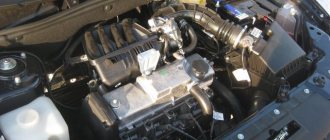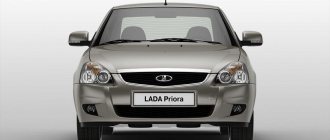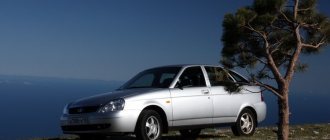Popular Priora model
In the spring of 2007, AvtoVAZ introduced a new model to consumers - the Lada Priora sedan. This car became the full-fledged successor to the VAZ 2110 family. Technical characteristics of the Priors of the first year of production outwardly differed little from the characteristics of their predecessors. A similar exterior, with the exception of the rear and front headlights, fenders, hood and decorative trims, an outdated brake system without ABS, with rear brake drums, a slightly reinforced outdated suspension - all this gave in total the same not very high technical characteristics as the cars tenth family. And a crash test conducted by Autoreview showed that the Lada Priora is not much different from the VAZ 2110 in the field of passive safety.
Summary data for Lada Priora (before restyling 2013)
The VAZ 2170 (this is exactly the indexing that Priora received) has an improved interior compared to the “ten”, a 16-valve engine with a volume of 1596 cc. see, and a 5-speed manual transmission in all trim levels (in the first trim levels of the sedan and hatchback with an 80 hp engine, an 8-valve engine was installed). In mixed driving mode, the Priora has 100 km. it takes from 6.6 to 7.6 liters. fuel outside the city (depending on the configuration), and in the city - 9.8 liters. The new engine allows you to accelerate to 180 km/h, and to “hundreds” in 12 seconds. This property attracts the attention of fans of high-speed racing, because by working on the engine and tuning the car, you can achieve good sports performance.
Performance characteristics of the Priora car engine: 126 and 127, how many horsepower and torque
The technical characteristics of the Priora car engine show 98 and 106 horsepower on board. This applies to engines with a displacement of 1.6 liters.
- Motor - 98 horsepower received number 21126. Maximum torque - 4000 rpm at 145 Nm.
- Motor - 106 horsepower is listed under number 21127, torque - 4,200 rpm at 148 km.
Motor 21127 is a modified version of the 126 model, but both of them are available with sixteen valves. In addition, the Priora has two eight-valve engines with a displacement of 1.6 liters, which produce 81 and 87 hp, but they are not as common as newer versions. Interestingly, there are engines with a volume of 1.8 liters.
- The first 1.8 liter engine produces 98 hp. (21127 also works), but the torque is 3000 rpm at 160 Nm.
- The 123 hp engine, which was installed on sports versions, produces 4000 rpm at 165 Nm.
Compared to the weight of the car, sixteen-valve engines are sufficient for free movement.
As for the technical condition, the VAZ-21126 and subsequent models are superior to eight-valve versions of engines, which is why car owners choose them more often. The most common “layout” is the Priora sedan with a 21126 engine and a manual transmission.
How much does Lada Priora weigh?
The weight of the car before restyling in 2013 was as follows:
- The 3-door hatchback coupe, 5-door hatchback and sedan have a curb weight (which includes the weight of a full tank of fuel and the driver) of 1088 kg. In this case, the total weight (i.e., the maximum permissible weight of the vehicle at which it can be operated after being fully loaded) is 1578 kg;
- The station wagon, with the same curb weight, is able to take a little more cargo, and its total weight reaches 1593 kg.
Thus, the station wagon is the most load-carrying of all Priora body types.
Cargo capacity
Cargo capacity (not payload!) of the Prior varies depending on the body type. So, trunks have different volumes:
- 360 liters – for hatchback and coupe;
- 430 liters - for the sedan;
- 444 liters - for the station wagon.
As we can see, this volume is not very different from the sedan’s, so it’s a very stretch to say that the Priora station wagon was created to solve a wide range of economic problems (relative to other variants of this car). Of course, cargo capacity increases significantly if you fold the back of the rear sofa, or even better, remove the entire rear seat.
Dimensions of VAZ 2170 and other modifications of Priora
The dimensions of the car are something that needs to be taken into account when purchasing, since the dimensions of parking spaces, garages, turns or entrance arches are not always universal. The height is measured from the extreme point of the front to the extreme point of the rear bumper. The width is measured at the widest point, and the height is measured from the surface of the ground to the highest point of the roof. Roof rails and racks do not fit into the height of the body. Taking this into account, the dimensions of the Priora are as follows:
- The longest body of cars in this family is the sedan. It measures 4350 mm in length. But at the same time it is the lowest - 1420 mm. in height.
- The next longest is the station wagon, with its 4340 mm length. It is the highest in height – 1508 mm.
- The five-door hatchback and three-door coupe are the shortest - 4210 mm. at 1435 mm. in height.
In all four cases, the width of the Priora is the same - 1680 mm. Ground clearance is 165 mm, although in the Priora Sport configuration it is somewhat reduced, but this is no longer so important, since this car is no longer produced in this version.
Body
In all versions of the Priora, the bodywork is mediocre. Drivers and experts had 2 complaints:
Susceptibility to rust. The body is made of ordinary steel, without alloying additives. For this reason, after the first winter it begins to actively rust and it will not be possible to stop this process.
Poor paintwork. Some noticed that it began to fall off in large “chips.” You will have to constantly visit the paint shop to paint over them, otherwise the corrosion process will be unstoppable.
Modifications of Lada Priora until 2013
VAZ 2170 Lada Priora I generation cars have the following body options: 4-door sedan, 5-door hatchback and station wagon, and 3-door coupe. Depending on the year of manufacture and configuration, engine power may vary, which looks like this.
Engine Lada Priora 2007, sedan, 1st generation
Based on the configuration, sedans before the 2013 restyling are equipped with the following engines:
- 80 “horses”: 8 valves, maximum speed 172 km/h, gasoline consumption – 7.6 liters. for every 100 km. in a mixed cycle.
- 16-valve engine with 89 hp. reaches speeds of up to 176 km/h, consuming 7.3 l/100 km. paths in a mixed cycle. As you can see, in terms of its characteristics, this engine is not much different from its “younger brother,” although it consumes a little less gasoline.
- 16-valve 98-horsepower engine: maximum speed 183 km/h, AI-95 consumption in the combined cycle – 7.2 l/100 km.
Engine Lada Priora 2008, hatchback, 1st generation
5-door hatchbacks have been produced since 2008. Depending on the configuration, they are equipped with:
- 80-horsepower 8-valve engine, delivering the same speed and fuel consumption characteristics as in the case of a sedan equipped with the same engine;
- 16-valve engine with 89 hp, which produces the same speed for a hatchback and consumes the same amount of gasoline as a sedan with the same engine;
- A 98-horsepower 16-valve engine, thanks to which the hatchback completely matches the speed and consumption characteristics of a sedan with the same power plant.
Engine Lada Priora 2008, station wagon, 1st generation
With a station wagon everything is simpler. From the very beginning of production, it had only one, but the most powerful engine at that time, producing 98 l/s, which accelerated the car to 183 km/h and consumed 7.2 liters of gasoline per 100 km. paths in a mixed cycle. Thus, despite the large cargo capacity of the station wagon, its rated speed remains the same as that of other Priors in a different body version, but with the same engine, since the curb weight is the same for all modifications. Probably, when fully loaded, the station wagon will show slightly lower speed or higher fuel consumption characteristics.
Engine Lada Priora 2010, coupe, 1st generation
Since 2010, Priora has received another modification - a three-door coupe-hatchback. Everything with him is also quite simple, because... It is equipped with a 98-horsepower 16-valve engine, giving a top speed of 183 km/h, consuming 7.4 liters of gasoline per 100 km in the combined cycle, i.e. slightly more than all other body modifications. As you can see, the station wagon and coupe do not have such a wide engine variation as the 5-door hatchback and sedan, since cars of such a body are not designed for wide sale, but for specific needs: sports and motor tourism. By the way, the creators of Priora had the idea to launch a convertible into series, but reasonably considering that it would not find its buyer, they abandoned this idea.
Subsequent versions of Lada Priora
Improved Priora model
At the end of 2008, a station wagon was presented to fans of the brand. It was longer than the hatchback but shorter than the sedan and had the same ground clearance and wheelbase as previous versions, but had the advantage of larger boot capacity. Buyers faced a new question: which is better - a station wagon, a sedan or a hatchback?
The answer came naturally in light of the appearance in November 2008 of the luxury version of the Lada Priora Premier. Possessing a more powerful power unit with a capacity of 120 hp. s., this stretch could reach speeds of up to 200 km/h. It was 175 mm longer, but had the same suspension and ground clearance as the other models in the family.
In 2011, a slight restyling of the VAZ Priora model range was carried out. A new bumper was added, configurations were changed, in particular, audio systems became paid for all modifications. In addition, a new 8-valve VAZ 21116 engine was added, developed on the basis of the Lada Kalina engine. The volume remained the same, but the power dropped to 87 hp. With. Acceleration to 100 km/h increased to 12.5 seconds.
At the beginning of 2013, rumors appeared about a possible stop in the production of cars of this model range; at that time, about 650,000 Priors of all modifications were produced. But in the summer of 2013, the plant management announced another modernization of the car. A new 106-horsepower engine was added to the engine line. The interior has been changed, but the appearance remains the same.
Restyling Lada Priora 2013
The 2013 restyling consisted of some changes regarding the appearance, some equipment, interior and engine. Among such changes in Prior we will name:
- A slightly modified exterior geometry, which, however, makes no sense to describe, since visually Priora before and after restyling remained almost indistinguishable in appearance;
- Replacing the radiator grille with an elongated “honeycomb”, slightly tilting the car into the now fashionable “organic” style, characterized by biological forms;
- Improved external lighting technology, thanks to which the car’s dimensions have become clearer in the dark. In particular, the area of the reflectors has been increased, LED sections for side lights and brake lights have been added, which are both brighter and more responsive when switched on;
- A dashboard that is implemented differently: instead of four “dials,” the sensor arrows were arranged in two, without compromising functionality. Purely aesthetically it looks better, but from an ergonomic point of view, a lot depends on habit;
- An increased number of pictograms flashing on the dashboard, making it easier to figure out which lighting equipment is faulty;
- An added niche in the center of the dashboard, in which the on-board computer is placed;
- Extended front seat slides, allowing tall drivers and front passengers to adjust their seat positions more flexibly;
- A box that is more spacious in depth to the right of the driver;
- A more attractive three-spoke steering wheel with an airbag under a triangular cover;
- In the “luxury” configuration – leather upholstery based on a combination of auto fabric and eco-leather;
- New door card design.
Also, since 2013, Priors have been produced in a different engine configuration, from which the 80-horsepower engine was removed, but a new 106 l/s engine was added, which, like everyone else, reaches speeds of up to 183 km/h and reduces fuel consumption to 6. 8 – 6.9 liters per hundred km. This engine is equipped with the “luxury” configurations of the Priora. Of course, such a reduction in fuel consumption is very attractive to the consumer. We can only hope that the developers will continue to work in this direction. In addition, the new engine fits well into Euro-3 and Euro-4 environmental standards, thanks to the closely located catalyst. Due to rapid heating, the catalysis of toxic substances occurs more vigorously, as a result of which a lower concentration of them enters the atmosphere.
The restyled Prior also has a drawback (compared to previous editions of this car): the carpet in the trunk is thinner than its predecessors, which is why the noise level while driving is higher. Motorists are advised to take care of additional sound insulation in the trunk. In addition, the curb weight of the car has increased (to 1185 kg), which is by as much as 100 kg. reduced its cargo capabilities, since the maximum weight remained the same - 1593 kg. for a station wagon, and 1578 kg. for other body variations.
Configurations of Lada Priora VAZ 2170 and other modifications
VAZ 2170 is known in the following configurations:
- “Standard” is the most budget package. It lacks: audio radio, speakers, air conditioning, rear headrests, immobilizer, central locking, heated front seats, electric drive and heated exterior mirrors, fog lights, remote trunk release. The front windows are electric, the rear windows are mechanical. The engine is 81 hp, which has been discontinued since 2013, and at the moment there are no longer orders for this configuration;
- “Norma”, which is equipped with an 87-, and after restyling - only a 98- and 106-power engine. Available: audio preparation, on-board computer, electric heating and electric drive of exterior mirrors, immobilizer, anti-theft alarm and all the elements of the “standard” equipment plus some new equipment. This configuration is in greatest demand due to its price niche. When you need a car “yesterday”, you have to buy what you have enough money for now, and everyone else has to retrofit the car in the process.
- "Norma+". In fact, this is the same standard for which one or more items of equipment are set: air conditioning, audio radio with speakers, ABS + BAS, child seat mounts, heated front seats and windshield;
- “Lux” is the most rich in functionality. It has everything that the “norm+” has, and in addition: side airbags, an airbag for the front passenger, rear and front electric windows, a navigator, a multimedia system, cruise control, parking sensors, fog lights, a rain sensor, a climate system , alloy wheels, heated front seats;
- “Sport” is a special package that increases the “sports” component. This is an aerodynamic body kit: a pronounced bumper with a spoiler, side sills, a diffuser rear bumper, and a wing on the trunk lid. The wheels with narrow profile tires are also different. Ground clearance, curb weight (up to 1080 kg) and maximum weight (up to 1500 kg) have been reduced. The interior has also been transformed: side supports have been added along the edges of the seats with red stitched seams, carbon fiber inserts, and a leather steering wheel. Air conditioning, radio, and a full set of electric windows are included. However, the production of sports Prioras was limited and today they are discontinued, although they can be found here and there on the highway, and most often these are Priora coupes.
Of course, this is not a complete, but only an indicative overview of the configurations of the Lada Priora, which is hardly possible to present in its entirety within the confines of one article. In addition, the equipment also differs somewhat depending on the body type. For example:
- Prior station wagons have roof rails, brackets on the wheel arches of the trunk, for which cargo can be strapped;
- For the coupe body, folding backrests and a reinforced frame of the front seats have been developed.
Source
Lada Priora Coupe... or 3Dr hatchback?
Coupe Lada Priora - prices and configurations. Technical characteristics of Priora Coupe, photos and review.
The small-scale Priora coupe first appeared in 2010 and every year gained popularity among fans of AvtoVAZ products. At the end of last year, the coupe underwent restyling, which gave the car more sportiness, and already at the beginning of this year the list of available trim levels for the three-door Lada Priora was expanded, making the new product much more attractive in terms of price.
The Lada Priora coupe was built on the basis of the hatchback of the same name, from which the sports car received not only the chassis, but also most of the body panels. A more sporty look is given to the new product by new bumpers, a spoiler and aerodynamic alloy wheels, available in the “Sport” package. As for the dimensions, the length of the coupe is 4210 mm in the base version and 4243 mm in the top version, the width of the body in all cases is 1680 mm, and the height is 1435 mm. The wheelbase of the coupe is 2492 mm. Curb weight does not exceed 1185 kg.
The interior of the Lada Priora Coupe is also based on the interior of the hatchback, so we won’t dwell on it, but just note that in the top version of the Lada Priora coupe, it receives a different instrument panel, seat and steering wheel upholstery made of artificial leather, as well as chrome inserts and gloss in the design of the front panel.
The coupe's trunk volume is similar to that of the hatchback and in its standard state holds 360 liters of cargo, but if you fold the rear row of seats, the usable space expands to 705 liters.
Specifications. If before the restyling, the Lada Priora coupe was offered with only one available engine, but now the range of engines has been replenished with a flagship power unit, previously announced on Priora sedans and hatchbacks. The base engine remains the same 1.6-liter in-line four-cylinder engine, capable of developing no more than 98 hp. power at 5600 rpm. The engine torque at its peak is 145 Nm at 4000 rpm, which allows the coupe to be accelerated to a maximum speed of 180 km/h, while consuming about 6.9 liters of gasoline for every 100 km in the combined cycle.
In the top modification, the Lada Priora Coupe also receives a 1.6-liter four-cylinder gasoline unit, but with a new system of electronically controlled distributed fuel injection and dynamic supercharging, thanks to which the maximum engine power is increased to 106 hp. at 5800 rpm. At the same time, it was not possible to achieve a significant increase in torque; its peak in the flagship engine is 148 Nm, developed at 4000 rpm, which is enough to complete the starting acceleration from 0 to 100 km/h in an average of 11.5 seconds. Note that with an increase in engine power, it has become slightly more economical than the younger model and consumes an average of about 6.8 liters per 100 km. Both engines are combined only with a 5-speed “mechanics”, which in the future is planned to be replaced with a similar one in steps, but with a cable drive.
As mentioned above, the Lada Priora Coupe chassis is borrowed from the updated Priora hatchback. This means that the coupe received an independent front suspension on MacPherson struts and a dependent structure at the rear. At the same time, the suspension settings have remained virtually unchanged and have undergone only minor adjustments, which should contribute to a more dynamic driving style.
Options and prices. The Lada Priora coupe is offered in three configuration options: “Standard”, “Normal” and “Sport”, while the coupe remains the only car in the Lada Priora line that has the basic “Standard” configuration, in which the manufacturer included only 14-inch stamped wheels, front airbags, power windows, audio preparation, trip computer, central locking, cabin filter, tilt-adjustable steering column and alarm system. The price of Lada Priora Coupe for 2015 in the basic version starts at 446,000 rubles. For the top-end “Sport” version, which includes alloy wheels, an aerodynamic body kit, ABS+BAS, leather upholstery, a 106-horsepower engine, a rain sensor, fog lights, electric drive/heated side mirrors, a multimedia system, electric power steering and climate control, you will have to pay not less than 488,900 rubles.
Lada Priora 2008 technical specifications, configurations and prices
In the spring of 2007, AvtoVAZ introduced a new model to consumers - the Lada Priora sedan. This car became the full-fledged successor to the VAZ 2110 family. Technical characteristics of the Priors of the first year of production outwardly differed little from the characteristics of their predecessors. A similar exterior, with the exception of the rear and front headlights, fenders, hood and decorative trims, an outdated brake system without ABS, with rear brake drums, a slightly reinforced outdated suspension - all this gave in total the same not very high technical characteristics as the cars tenth family. And a crash test conducted by Autoreview showed that the Lada Priora is not much different from the VAZ 2110 in the field of passive safety.
Review of the Lada Priora hatchback
Improved Lada The new Priora model is very often compared with its predecessor VAZ-2112. Despite the apparent similarity, the Priora has more than enough differences with the cars of the 10th family. The geometric clarity of the body and more streamlined outlines give it a stylish appearance. The hatchback body implies a sports-class car, which is evidenced by the power of this model.
Of course, the attitude towards quality at the Volzhsky Automobile Plant that has changed for the better also plays a role. A more rigid body behaves confidently when cornering and does not “moan” on bad roads. In addition, even in a hatchback body, Priora is much safer than its predecessors thanks to airbags and amplifiers.
Asking the question: is the 2013 Lada Priora hatchback a new car or a regular restyling of the Lada 12th model, let’s look at their similarities and differences. The appearance of the Priora is indeed a little similar to the VAZ-2112, especially its front part. The rear part looks more harmonious than previous models.
Transmission
Initially, the hatchback came with a manual transmission. In fact, it was a strengthened version of the gearbox from the 110th Lada. Drivers immediately noted the poor quality of the mechanics, which became known for having very poor synchronizers. Often the handle simply “jumped” out of gear or the desired mode simply did not turn on.
The release lever began to knock just 3 months after purchase, and unclear shifts were observed immediately from the passenger compartment.
Subsequently, the restyled version of “2180” received updated mechanics, which worked much smoother. The sudden knocks disappeared and shifts became smooth. Afterwards, AvtoVAZ updated the gearbox and installed a robotic version, which received mixed reviews. However, it is very reliable and convenient; there are no reviews about its inoperability.
Modifications of the Priora line
Nissan Teana 2011 technical specifications, configurations and prices
In 2007, this car replaced the VAZ 2110 model. Restyling allowed the new car to differ significantly from the previous version, as more than 900 changes were made. The very first modification is called Lada 21701 and is a sedan with five doors. It was equipped with the lowest-power engine in the line: 80 horsepower. Number of valves - 8.
Various modifications and configurations of the Lada 2170 have characteristic differences and a corresponding prefix in the model number. Model 217030 was the first upgraded version of the basic version. This car is equipped with a more powerful 98-horsepower engine, and the interior was equipped with a number of options:
- tinted windows;
- headlight corrector;
- ABS (anti-lock braking system),
- front power windows;
- airbag;
- alarm.
In 2011, AvtoVAZ made a slight restyling of the body, in particular, the front and rear bumpers. Several options were also added: new rear-view mirrors and a redesigned steering wheel. The shortcomings of the first model were eliminated. The updated car was named VAZ 21704. The Lada 217050 modification, released later, became even more modern thanks to electric power steering and a brake force distribution system.
Starting in 2014, VAZ Priora cars began to be equipped with a semi-automatic robotic transmission, which was developed by AvtoVAZ based on a 5-speed manual transmission. The electronic control unit is assembled from components manufactured by the German company ZF. A year later, the concern decided to stop producing cars with AMT.
During its release, Priora was available in 4 body styles. In addition to the existing sedan, production of hatchbacks with both five and three doors began in February 2008. In the spring of 2009, the concern began production of serial models of the Lada 2170 station wagon. Production of the car in hatchback and station wagon versions was discontinued at the end of 2015. Today, only Lada 2170 sedans are produced.
Today, there are 2 modifications left in the Priora line. Their main differences are engine size and power. The first option is equipped with a 16-valve, 106-horsepower power unit. The second one has an 8-valve engine with 87 horsepower under the hood.
Technical modification data
The modification is a good budget car. It belongs to class B and has a high degree of environmental friendliness - Euro4.
How much does a Hatchback body weigh? In factory configuration, without load, its weight is only 1088 kilograms.
Compared to other versions of the Priora, the suspension was not strengthened here. The front spring remained independent, and the rear was partially independent. The front brake is ventilated and has a disc locking type, the rear brakes are drum brakes. The use of a robotic automatic transmission in the modification made the car “friendlier” and easier to drive, even for inexperienced drivers.
The headlight glass has been changed in many ways to better distribute light. The body, interior, steering wheel and multimedia devices were also slightly changed.
Lada Priora luxury class
In parallel with the release of the budget Lada Priora hatchback, a luxury car with many additional elements and accessories called the Priora hatchback luxury is being produced. Luxury cars, in addition to basic equipment, are additionally equipped with a climate control system, fog lights, heated front seats, and power windows. AvtoVAZ is planning to soon add new additional elements to the luxury hatchback.
Recently, luxury Lada Priora cars have received a standard audio system. Integrated into the dashboard, the audio system includes four speakers and a highly sensitive antenna. The radio is both a radio receiver and a disk player, a USB drive, and Bluetooth. The 2013 Lada Priora hatchback is the first domestic luxury car for which a personal audio system has been developed.
Another detail worth paying attention to is the parking sensors. Priora is the only domestic car on which sensors are already installed in production. Previously, they could only be ordered from dealers or other car service companies.
The shape of the handles has also changed; now it is a handle for a natural grip. Opening the door with such a handle is much more convenient than those that were on the 12th model. The handle is equipped with a cover in body color, which helps protect it from scratches.
If we consider the changes in the interior compared to the Lada 12th model, they are simply colossal. Different materials, different design and completely different workmanship. Comparing the front panel with the Priora sedan, at first glance, the differences do not seem obvious. But for the first time, two airbags for the driver and front passenger appeared on the Lada Priora hatchback. A button to turn on the air conditioner has also been added. The interior of the Lada Priora, of course, is far from the standard. There are errors both in the materials and in the solutions, but progress is obvious. Today, the materials and ergonomics of the interior of the 2013 Priora hatchback are some of the best among other Russian models.
The rear seat, divided into two parts (2 to 1) and equipped with a backrest with a cushion, has already won particular respect. In combination with a more spacious trunk compared to its predecessors, the Lada Priora hatchback allows you to simultaneously transport large cargo and several passengers.
The Lada Priora hatchback can be called a city car, designed for the younger generation and people with an active attitude. Its main advantage is the dynamics and comfort worthy of a sports car.
What is good about the Lada Priora hatchback?
The answer to this question lies in the plane of what advantages such a body variation has in general. Firstly, it is a sportier and more dynamic look, which is preferred by young buyers, even taking into account the fact that the sedan looks more solid. Secondly, its compact size and the shortest wheelbase make it easier to maneuver and park in urban environments. Above we have already described the dimensions of the hatchback. Thirdly, the absence of a protruding stern, which creates difficulties when parking and reversing. Fourthly, a wide luggage opening (despite the fact that the Priora sedan has a larger trunk in volume), allowing for the stowage of large cargo.
Thus, the Priora hatchback is an excellent choice for those who do not burden themselves too much with pressing problems, preferring to devote time to the simple joys of life. This is a car for driving, not for transportation, which will be appreciated by young car enthusiasts, athletes, and those who do not intend to grow old.
Source
“Lada Priora” in a new role
Lexus GS 450h 2008 technical specifications, configurations and prices
COMPETITION in market conditions is a great thing! It seems that Russian automakers have finally begun to understand this. At least the “Lada Priora” station wagon, even with a purely “theoretical” acquaintance, clearly differs in a positive direction from similar models in a similar price segment. In the “Lux” package, for example, rain and light sensors are installed here. In cars of similar cost, you won’t even get such equipment as an option. Well, the VAZ station wagon is already equipped with climate control, ABS, electric windows and alloy wheels in the basic version.
Specifications
The new Lada Priora 2013 is not much different from a sedan in terms of technical characteristics. The characteristics and type of engine are also identical. This model is equipped with one 16-valve 1.6-liter engine with a capacity of 98 hp. With.
General characteristics of Priora hatchback
| Length, cm | 421 |
| Width, cm | 168 |
| Height, cm | 142 |
| Luggage compartment size, dm3 | 400 |
| Vehicle weight, kg | 1578 |
| Drive unit | front |
| Body type | hatchback |
| Number of doors | 5 |
| Engine | petrol |
| Number of cylinders | 4 |
| Engine volume, cm3 | 1596 |
| Maximum power, kW/rpm | 72/5600 |
| Fuel | gasoline AI-95 |
| Fuel consumption in liters per 100 km | 7,2 |
| Maximum speed, km/h | 183 |
| Transmission | Manual control |
| Steering | electric power steering |
| Fuel tank capacity | 43 |
Engine after restyling
Coming off the assembly line in 2007, the car was equipped with 1 of 3 engines that were released gradually. Technical characteristics of LADA Priora 2010 look like this:
- Engine with 8 valves and 81 hp. At peak it produces 171 kilometers per hour, which was not bad at the time of release. Many drivers complained about inefficient fuel consumption: 7.5/100. Versions with this engine cost less than others, but they also ate much more gasoline.
- The 16-valve engine had 89 horsepower and could reach up to 176 kilometers. Fuel consumption is lower - 7.2 liters. In general, this medium engine was installed on the Optima version.
- The most “Top” version was equipped with an engine with 16 valves and 98 horsepower. It could accelerate 183 kilometers and consumed 7.4 liters.
Please note that now it makes no sense to buy cars produced before restyling. Buying spare parts can cost a pretty penny.
Vehicle body and layout
Body type VAZ 2171 is a five-seater, five-door station wagon. The fifth door is solid and opens upward. The overall dimensions of the Lada Priora station wagon (body length, width and height) are 4210, 1680 and 1420 mm, respectively. The height is indicated taking into account the roof rails, which are not removable. For the Lada Priora station wagon, 10 body color options are offered: from black and dark red to white and silver. The "Lada Priora" station wagon in "Snow Queen" color is most suitable for southern regions, since it heats up less from the sun. In summer, cars of this color will not be so hot.
The vehicle's wheelbase (the distance between the front and rear axles) is 2492 mm. The front track is 1410 mm, the rear is slightly larger, its size is 1380 mm. Ground clearance (or ground clearance) is 170 mm. The trunk of the Priora station wagon has a volume of 444 cubic dm, and with the rear row seats folded, the volume will increase to 777 cubic dm, but the seats do not fold flat. Lada Priora 2171 has a front-wheel drive layout with a front transverse engine. The wheel arrangement is 4×2 (the car has 4 wheels, 2 of which are driving).
Tuning and accessories
Lada priora 2013 is a relatively inexpensive, but outwardly quite solid car. Although all domestic production cars, without exception, are of the same type, due to which they simply get lost among the wide variety of foreign cars. This situation can be corrected with the help of additional tuning kits. The laconic appearance of the Priora hatchback VAZ-2172 can be changed by the hood, bumper, wheel arches and wings. In general, with tuning for the Lada Priora there is a lot to roam around. The thresholds will help make the car squat, which will add features of a sports car to its appearance.
So, for example, any sports tuning kit for the 2013 Lada Priora hatchback will not only give a stylish look to your car, but will also significantly improve its aerodynamics. Volumetric and streamlined front bumpers with or without gills will give the car an elegant, but at the same time aggressive appearance. Thresholds and door trims will increase the volume of the lower part of the Priora hatchback and create a single harmonious picture in combination with the bumpers. Smooth lines, airiness and additional streamlining of the Lada Priora VAZ-2172 will be provided by rear bumpers. A low spoiler will increase downforce and aerodynamics. All tuning elements are made from high-quality materials, usually ABS plastic.
Tuning Lada Priora is most often aimed specifically at sports. But the VAZ-2172 can be styled not only as a sports class; there are both more aggressive elements and classic ones. In any case, each owner of this car will find a suitable option for himself and, if desired, will be able to change the appearance of the car beyond recognition. After all, a large assortment of tuning kits for the Priora hatchback provides ample opportunities for creativity.
Conclusion
Drawing conclusions, we can say that in general the Priora is the best car for the money they ask for it. She feels quite confident in the city and on the dirt road, while the type of her body has practically no effect on the “filling” itself.
In principle, the technical differences between a hatchback and a sedan are not fundamental at all. Therefore, when choosing between one body type or another, you can focus solely on your taste preferences and personal preferences. Some people prefer a classic, roomy car, while others prefer a fashionable and more modern model with attractive rear lights.
The price of the hatchback and sedan also differs slightly. In the first option, the car will cost you 10-20 thousand rubles more, depending on the year of manufacture and the configuration you choose.
Source










